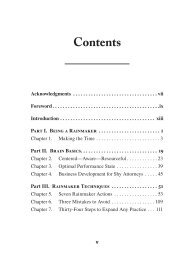(Bk Business) Carol Kinsey Goman Ph.D.-The Nonverbal Advantage_ Secrets and Science of Body Language at Work -Berrett-Koehler Publishers (2008)
Just
Just
Create successful ePaper yourself
Turn your PDF publications into a flip-book with our unique Google optimized e-Paper software.
72 <strong>The</strong> <strong>Nonverbal</strong> <strong>Advantage</strong><br />
Blushing Cheeks<br />
No other part <strong>of</strong> the body reacts more dram<strong>at</strong>ically to a flow<br />
<strong>of</strong> blood than the cheeks. This telltale sign is a simple physiological<br />
fact. When you are emotionally aroused—whether<br />
angry or excited—blood rushes to the face in various degrees.<br />
And when a person is nervous or embarrassed, he blushes.<br />
Taut Skin<br />
Tenseness <strong>and</strong> anger can be detected by looking for tightness<br />
around the cheeks, along the jaw line, <strong>and</strong> in the neck. To get<br />
a feel for this, try holding your bre<strong>at</strong>h <strong>and</strong> feel the increased<br />
stiffness in these areas on yourself.<br />
Smiles: Real <strong>and</strong> Fake<br />
A fake smile is the most common facial expression used to<br />
mask other emotions. A person who doesn’t want her true<br />
feelings revealed (especially if she wants to disguise displeasure<br />
or anger) may “put on a happy face.”<br />
Dr. Paul Ekman identified eighteen distinct smiles—most<br />
<strong>of</strong> them false. One <strong>of</strong> the most common in organiz<strong>at</strong>ional<br />
situ<strong>at</strong>ions is the “qualifier” smile, which bosses use when<br />
rejecting an idea or criticizing an employee. And we all use<br />
the fake smile in business settings when we don’t really feel<br />
an emotional closeness to those around us; the real smile is<br />
reserved for those we truly care about.<br />
We’ve had a lot <strong>of</strong> practice doing this. We’ve been displaying<br />
both real <strong>and</strong> fake smiles all our lives. According to<br />
studies <strong>at</strong> the University <strong>of</strong> Maryl<strong>and</strong>, ten-month-old infants<br />
curve their lips in response to the coo <strong>of</strong> friendly strangers,<br />
but they produce happy, genuine smiles only <strong>at</strong> the approach<br />
<strong>of</strong> their mothers.<br />
A fake smile is easy to produce: it takes only one set <strong>of</strong><br />
muscles to stretch the lip corners sideways <strong>and</strong> cre<strong>at</strong>e a grin.<br />
But a false smile is also easy to detect. A genuine smile not




